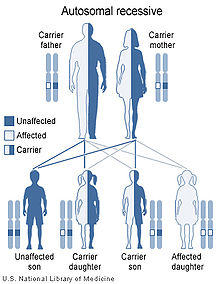- Gunther disease
-
Gunther disease Classification and external resources 
Hydroxymethylbilane, precursor to uroporphyrinogen III.ICD-10 E80.0 ICD-9 277.1 OMIM 263700 DiseasesDB 3048 eMedicine derm/145 MeSH D017092 Gunther disease, also known as congenital erythropoietic porphyria (CEP), uroporphyrinogen III synthase deficiency and UROS deficiency,[1][2] is a congenital form of erythropoietic porphyria. It is a rare, autosomal recessive[3] metabolic disorder affecting heme, caused by deficiency of the enzyme uroporphyrinogen cosynthetase.[4] It is extremely rare, with a prevalence estimated at 1 in 1,000,000 or less.[5]
Contents
Genetics
Gunther disease is caused by mutations in the gene that encodes the enzyme uroporphyrinogen III synthase (UROS), located at human chromosome 10q25.2-q26.3.[3][6] The disorder is inherited in an autosomal recessive manner.[3] This means the defective gene responsible for the disorder is located on an autosome, and two copies of the defective gene (one inherited from each parent) are required in order to be born with the disorder. The parents of an individual with an autosomal recessive disorder both carry one copy of the defective gene, but usually do not experience any signs or symptoms of the disorder.
Eponym
The disorder is named after the scientist who discovered it, Hans Gunther.[7]
See also
References
- ^ Online 'Mendelian Inheritance in Man' (OMIM) 263700
- ^ James, William D.; Berger, Timothy G.; et al. (2006). Andrews' Diseases of the Skin: clinical Dermatology. Saunders Elsevier. pp. 526. ISBN 0-7216-2921-0.
- ^ a b c Deybach JC, De Verneuil H, Boulechfar S, Grandchamp B, Nordmann Y (1990). "Point mutations in the uroporphyrinogen III synthase gene in congenital erythropoietic porphyria (Gunther's disease)". Blood 75 (9): 1763–5. ISSN 0006-4971. PMID 2331520.
- ^ Robert-Richard E, Moreau-Gaudry F, Lalanne M, et al. (January 2008). "Effective gene therapy of mice with congenital erythropoietic porphyria is facilitated by a survival advantage of corrected erythroid cells". Am. J. Hum. Genet. 82 (1): 113–24. doi:10.1016/j.ajhg.2007.09.007. PMC 2253957. PMID 18179890. http://www.pubmedcentral.nih.gov/articlerender.fcgi?tool=pmcentrez&artid=2253957.
- ^ Thadani, H.; Deacon, A.; Peters, T. (2000). "Diagnosis and management of porphyria". BMJ 320 (7250): 1647–1651. doi:10.1136/bmj.320.7250.1647. PMC 1127427. PMID 10856069. http://www.pubmedcentral.nih.gov/articlerender.fcgi?tool=pmcentrez&artid=1127427.
- ^ Online 'Mendelian Inheritance in Man' (OMIM) 606938
- ^ Madan P, Schaaf CP, Vardhan P, Bhayana S, Chandra P, Anderson KE (2007). "Hans Gunther and his disease". Photodermatol Photoimmunol Photomed 23 (6): 261–3. doi:10.1111/j.1600-0781.2007.00323.x. PMID 17986065. http://www.blackwell-synergy.com/openurl?genre=article&sid=nlm:pubmed&issn=0905-4383&date=2007&volume=23&issue=6&spage=261.
External links
- 1208352782 at GPnotebook
- Medical dictionary
- Porphyria, congenital erythropoietic at NIH's Office of Rare Diseases
Heme metabolism disorders (E80, 277.1, 277.4) Porphyria,
hepatic and erythropoietic
(porphyrin)cytoplasmic: Gunther disease/congenital erythropoietic porphyria · Porphyria cutanea tarda/Hepatoerythropoietic porphyriaHereditary hyperbilirubinemia
(bilirubin)Categories:- Autosomal recessive disorders
- Rare diseases
- Skin conditions resulting from errors in metabolism
- Porphyria
- Genetic disorder stubs
Wikimedia Foundation. 2010.

